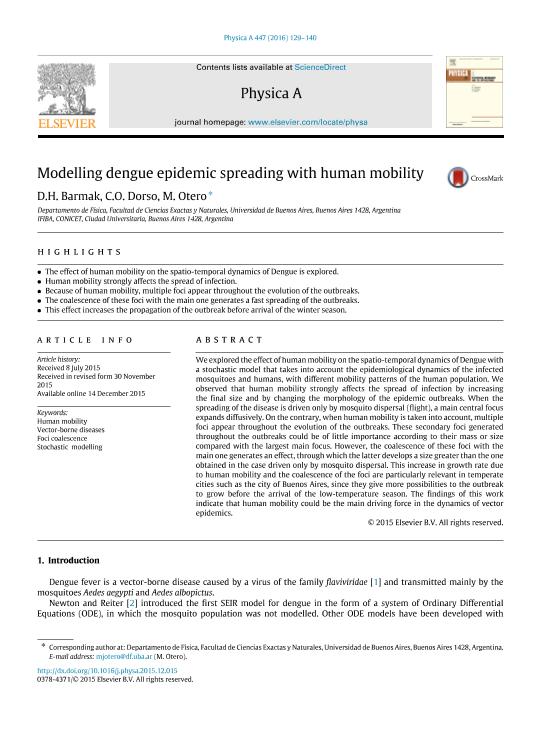Artículo
Modelling dengue epidemic spreading with human mobility
Fecha de publicación:
04/2016
Editorial:
Elsevier Science
Revista:
Physica A: Statistical Mechanics and its Applications
ISSN:
0378-4371
Idioma:
Inglés
Tipo de recurso:
Artículo publicado
Clasificación temática:
Resumen
We explored the eect of human mobility on the spatio-temporal dynamics of Dengue with a stochastic<br />model that takes into account the epidemiological dynamics of the infected mosquitoes and humans, with<br />dierent mobility patterns of the human population. We observed that human mobility strongly aects<br />the spread of infection by increasing the nal size and by changing the morphology of the epidemic<br />outbreaks. When the spreading of the disease is driven only by mosquito dispersal (<br />ight), a main<br />central focus expands diusively. On the contrary, when human mobility is taken into account, multiple<br />foci appear throughout the evolution of the outbreaks. These secondary foci generated throughout the<br />outbreaks could be of little importance according to their mass or size compared with the largest main<br />focus. However, the coalescence of these foci with the main one generates an eect, through which the<br />latter develops a size greater than the one obtained in the case driven only by mosquito dispersal. This<br />increase in growth rate due to human mobility and the coalescence of the foci are particularly relevant<br />in temperate cities such as the city of Buenos Aires, since they give more possibilities to the outbreak<br />to grow before the arrival of the low-temperature season. The ndings of this work indicate that human<br />mobility could be the main driving force in the dynamics of vector epidemics.<br />Keywords: Human mobility, vector-borne diseases, foci coalescence, stochastic modeling
Palabras clave:
Epidemiology
,
Dengue
,
Human Mobility
,
Morphology
Archivos asociados
Licencia
Identificadores
Colecciones
Articulos(IFIBA)
Articulos de INST.DE FISICA DE BUENOS AIRES
Articulos de INST.DE FISICA DE BUENOS AIRES
Citación
Barmak, Daniel Hernan; Dorso, Claudio Oscar; Otero, Marcelo Javier; Modelling dengue epidemic spreading with human mobility; Elsevier Science; Physica A: Statistical Mechanics and its Applications; 447; 4-2016; 129-140
Compartir
Altmétricas




